Richard L. Daft - Management. 9th ed., 2010
Подождите немного. Документ загружается.


PART 6 CONTROLLING540
of the contemporary organization.
6
British Airways, for example, measures its perfor-
mance in key areas of customer service because its strategy is to compete on superior
service in an industry dominated by companies that compete on price. Underpinning
this strategy is a belief that delivery of excellent service will result in higher levels
of customer retention and pro tability. Thus, British Airways measures and controls
areas of customer service that have the greatest impact on a customer’s service expe-
rience, including in- ight service, meal rating, baggage claim, and executive club
membership.
7
Instead of relying only on nancial measures to judge the company’s
performance, British Airways uses a number of different operational measures to
track performance and control the organization.
The Balanced Scorecard
Like British Airways, many rms are now taking a more balanced perspective of
company performance, integrating various dimensions of control that focus on mar-
kets and customers as well as employees and nancials.
8
Organizations recognize
that relying exclusively on nancial measures can result in short-term, dysfunctional
behavior. Non nancial measures provide a healthy supplement to the traditional
nancial measures, and companies are investing signi cant sums in developing more
balanced measurement systems as a result.
9
The balanced scorecard is a comprehen-
sive management control system that balances traditional nancial measures with
operational measures relating to a company’s critical success factors.
10
A balanced scorecard contains four major perspectives, as illustrated in
Exhibit 18.1: nancial performance, customer service, internal business processes,
and the organization’s capacity for learning and growth.
11
Within these four areas,
managers identify key performance metrics the organization will track. The nancial
performance perspective re ects a concern that the organization’s activities contrib-
ute to improving short- and long-term nancial performance. It includes traditional
measures such as net income and return on investment. Customer service indicators
measure such things as how customers view the organization, as well as customer
retention and satisfaction. Business process indicators focus on production and oper-
ating statistics, such as order ful llment or cost per order. A good example of busi-
ness process indicators comes from Facebook, one of the fastest-rising dot-coms in
history. One of the internal activities it measures is the number of minutes visi-
tors spend at its site. In March 2008, Facebook visitors spent a whopping 20 billion
minutes at the site, compared to 6.4 billion minutes a year earlier. By measuring
“minutes per visitor,” Facebook is able to track its performance and adjust its strat-
egy in response.
12
The nal component of the balanced scorecard looks at the organization’s potential
for learning and growth, focusing on how well resources and human capital are being
managed for the company’s future. Metrics may include such things as employee
retention and the introduction of new products. The components of the scorecard are
designed in an integrative manner, as illustrated in Exhibit 18.1.
Managers record, analyze, and discuss these various metrics to determine how
well the organization is achieving its strategic goals. The balanced scorecard is an
effective tool for managing and improving performance only if it is clearly linked
to a well-de ned organizational strategy and goals.
13
At its best, use of the score-
card cascades down from the top levels of the organization so that everyone becomes
involved in thinking about and discussing strategy.
14
The scorecard has become the
core management control system for many organizations, including well-known
organizations such as Bell Emergis (a division of Bell Canada), ExxonMobil, Cigna
Insurance, Hilton Hotels Corporation, and even some units of the U.S. federal gov-
ernment.
15
As with all management systems, the balanced scorecard is not right for
every organization in every situation. The simplicity of the system causes some man-
agers to underestimate the time and commitment that is needed for the approach to
become a truly useful management control system. If managers implement the bal-
anced scorecard using a performance measurement orientation rather than a performance
b
b
b
b
b
b
bal
a
n
ced
sco
r
ec
a
r
d
A
c
c
c
co
co
o
m
c
c
c
p
re
p
h
h
en
i
s
i
ve mana
g
em
g
t
en
t
c
c
c
c
co
o
ntro
l
s
y
stem t
h
at
b
a
l
ances
t
t
t
r
r
r
a
d
itiona
l
fi
nancia
l
measures
w
w
w
w
w
w
w
it
h
measures o
f
customer
s
s
s
s
se
e
rvice, interna
l
b
usiness
p
p
p
p
p
rocesses, and the organiza
-
t
t
t
i
i
on’s capacity for learning and
g
g
g
g
gr
r
owth.
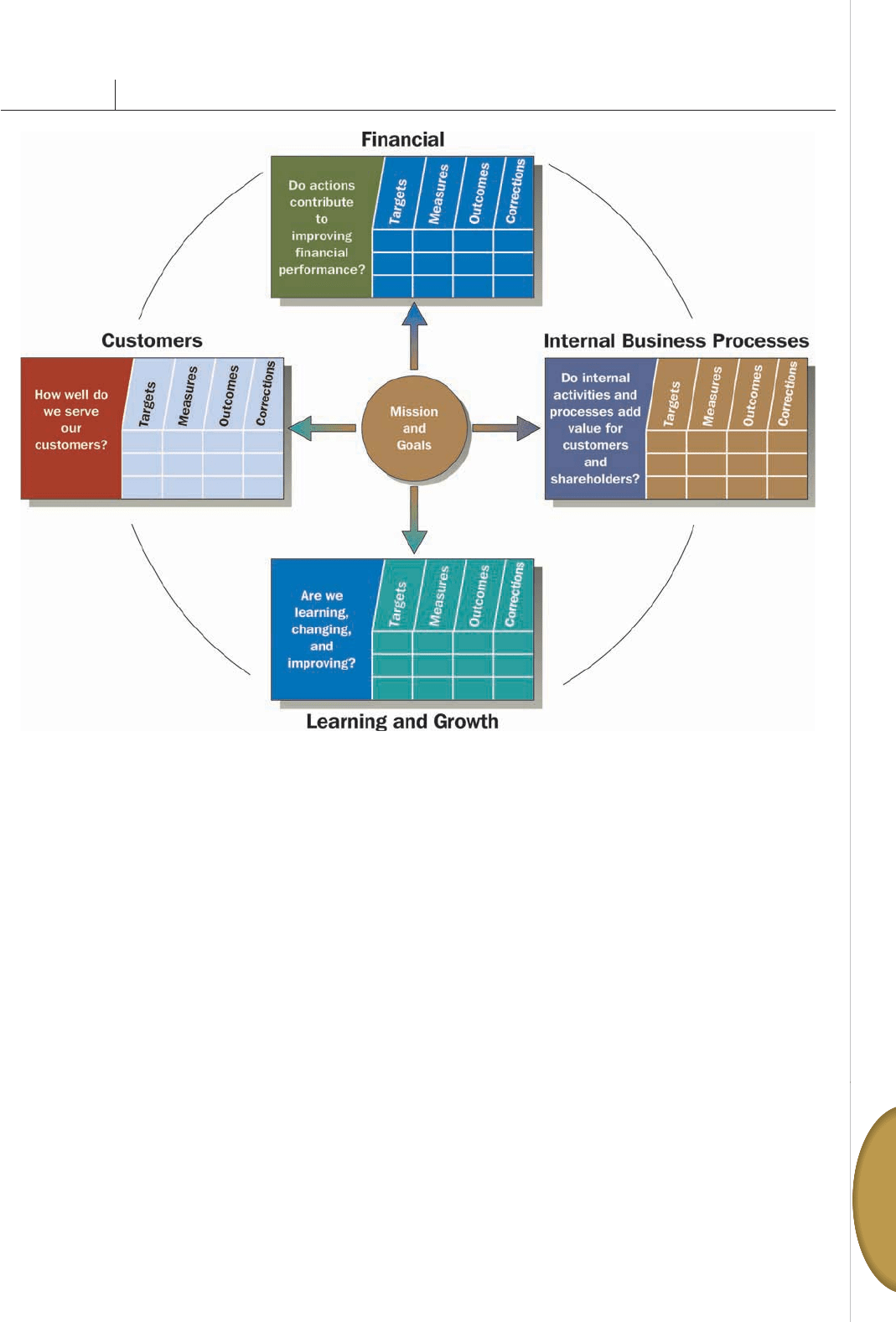
CHAPTER 18 MANAGING QUALITY AND PERFORMANCE 541
Controlling
6
management approach that links targets and measurements to corporate strategy, use
of the scorecard can actually hinder or even decrease organizational performance.
16
FEEDBACK CONTROL MODEL
All well-designed control systems involve the use of feedback to determine whether
performance meets established standards. Managers need feedback, for example, in
each of the four categories of the balanced scorecard. British Airways ties its use of the
balanced scorecard to a feedback control model. Scorecards are used as the agenda for
monthly management meetings. Managers focus on the various elements of the score-
card to set targets, evaluate performance, and guide discussion about what further
actions need to be taken.
17
In this section, we examine the key steps in the feedback
control model and then look at how the model applies to organizational budgeting.
Steps of Feedback Control
Managers set up control systems that consist of the four key steps illustrated in
Exhibit 18.2: Establish standards, measure performance, compare performance to
standards, and make corrections as necessary.
EXHIBIT 18.1 The Balanced Scorecard
SOURCES: Based on Robert S. Kaplan and David P. Norton,“Using the Balanced Scorecard as a Strategic Management System,”Harvard Business Review (January–
February 1996): 75–85; and Chee W. Chow, Kamal M. Haddad, and James E.Williamson,“Applying the Balanced Scorecard to Small Companies,”Management
Accounting 79, no. 2 (August 1997): 21–27.
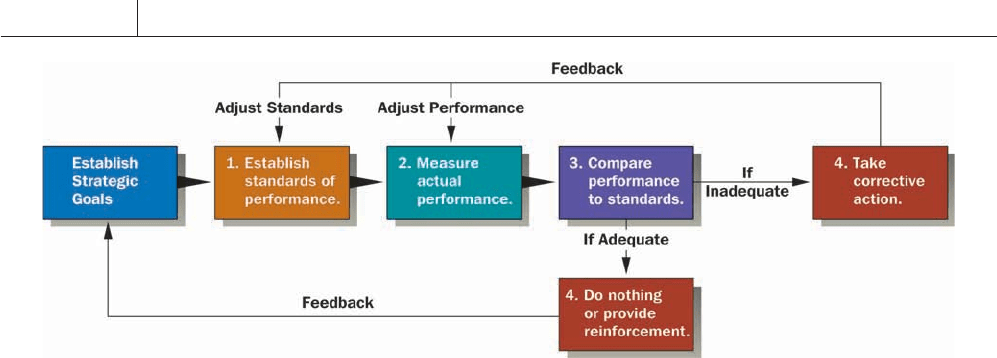
PART 6 CONTROLLING542
Establish Standards of Performance Within the organization’s overall strategic
plan, managers de ne goals for organizational departments in speci c, operational
terms that include a standard of performance against which to compare organizational
activities. A standard of performance could include “reducing the reject rate from 15
to 3 percent,” “increasing the corporation’s return on investment to 7 percent,” or
“reducing the number of accidents to one per each 100,000 hours of labor.” Manag-
ers should carefully assess what they will measure and how they will de ne it. In
the auto industry, crash test ratings provide a standard of performance established
by the National Highway Traf c Safety Administration. When crash test ratings are
below standard, managers rethink design and manufacturing processes to improve
crash test results. Although Daimler’s ultra-tiny Smart ForTwo car won a Five Star
rating for driver protection, it won just a Three Star rating for passenger protection,
indicating the need for improved passenger safety features.
18
Tracking such measures as customer service, employee involvement, or, for auto
manufacturers, crash test results, is an important supplement to traditional nancial
and operational performance measurement, but many companies have a hard time
identifying and de ning non nancial measurements.
19
To effectively evaluate and
reward employees for the achievement of standards, managers need clear standards
that re ect activities that contribute to the organization’s overall strategy in a sig-
ni cant way. Standards should be de ned clearly and precisely so employees know
what they need to do and can determine whether their activities are on target.
20
Measure Actual Performance Most organizations prepare formal reports of
quantitative performance measurements that managers review daily, weekly, or
monthly. These measurements should be related to the standards set in the rst step
of the control process. For example, if sales growth is a target, the organization should
have a means of gathering and reporting sales data. If the organization has identi ed
appropriate measurements, regular review of these reports helps managers stay aware
of whether the organization is doing what it should. Technology is aiding many orga-
nizations in measuring performance. For example, GPS tracking devices installed on
government-issued vehicles are helping many communities reduce waste and abuse,
in part by catching employees shopping, working out at the gym, or otherwise loaf-
ing while on the clock. Although some claim this technology is intrusive, city of cials
claim that tracking the whereabouts of government employees has deterred abuses
and saved taxpayers money. In Denver, 76 vehicles equipped with GPS units were
driven 5,000 fewer miles than the unequipped eet during the same period the year
before, indicating the value of this type of quantitative measure.
21
In most companies, managers do not rely exclusively on quantitative measures.
They get out into the organization to see how things are going, especially for such
EXHIBIT 18.2 Feedback Control Model

CHAPTER 18 MANAGING QUALITY AND PERFORMANCE 543
Controlling
6
goals as increasing employee participation or improving customer satisfaction. Man-
agers have to observe for themselves whether employees are participating in deci-
sion making and have opportunities to add to and share their knowledge. Interaction
with customers is necessary for managers to really understand whether activities are
meeting customer needs.
Compare Performance to Standards The third step in
the control process is comparing actual activities to perfor-
mance standards. When managers read computer reports
or walk through the plant, they identify whether actual per-
formance meets, exceeds, or falls short of standards. Typi-
cally, performance reports simplify such comparisons by
placing the performance standards for the reporting period
alongside the actual performance for the same period and
by computing the variance—that is, the difference between
each actual amount and the associated standard. To correct
the problems that most require attention, managers focus
on variances.
When performance deviates from a standard, manag-
ers must interpret the deviation. They are expected to dig
beneath the surface and nd the cause of the problem.
If the sales goal is to increase the number of sales calls
by 10 percent and a salesperson achieved an increase of
8 percent, where did she fail to achieve her goal? Perhaps
several businesses on her route closed, additional sales-
people were assigned to her area by competitors, or she
needs training in making cold sales calls more effectively.
Managers should take an inquiring approach to devia-
tions to gain a broad understanding of factors that in u-
ence performance. Effective management control involves
subjective judgment and employee discussions, as well as
objective analysis of performance data.
As a new manager, apply the feedback control model to determine whether
your team is functioning well or if changes are needed. Defi ne clear standards of
performance, measure outcomes regularly, and work with team members to take
corrective actions when necessary.
Take Corrective Action Managers also determine what changes, if any, are
needed. In a traditional top-down approach to control, managers exercise their for-
mal authority to make necessary changes. They may encourage employees to work
harder, redesign the production process, or re employees. In contrast, managers
using a participative control approach collaborate with employees to determine
the corrective action necessary. As an example, Toyota’s commitment to continuous
improvement is re ected in its philosophy of “Problems First.” In staff meetings, fac-
tory managers are asked to present their “problems rst,” triggering problem-solving
sessions with managers that generate solutions. This approach re ects the company’s
commitment to seeking out better ways to manufacture cars. “Even with projects that
had been a general success, we would ask, ‘What didn’t go well so we can make it
better?’” says James Wiseman, vice president of corporate affairs for Toyota manufac-
turing in North America.
22
Managers may wish to provide positive reinforcement when performance meets
or exceeds standards. For example, they may reward a department that has exceeded
its planned goals or congratulate employees for a job well done. Managers should
TakeaMoment
EVAN KAFKA
Is it possible to make scientifi c
discovery effi cient? Managers at pharmaceuticals company Wyeth
think so. They devised a streamlined research and development sys-
tem driven by ambitious, quantifi able standards of performance.
Managers routinely compare performance to standards and issue
automated scorecards for each individual. Wyeth ties compensa-
tion to accomplishment of these all-or-nothing targets. “If the
goal was to discover 12 drugs, 11 drugs are worth no points,” says
Wyeth Research President Robert Ruffolo Jr., who oversaw the reen-
gineering effort. So far, the approach has yielded impressive results.
With no additional investment, Wyeth has seen the number of new
drugs that emerge from the early discovery phase increase fourfold.

PART 6 CONTROLLING544
not ignore high-performing departments at the expense of taking corrective actions
elsewhere. The online auction company eBay provides a good illustration of the feed-
back control model.
As CEO of eBay, one of Meg Whitman's guiding rules was “If you can’t measure it, you can’t
control it.” Whitman has moved on to other pursuits, but eBay is still a company obsessed
with performance measurement. Top managers personally monitor a slew of performance
metrics, including standard measurements such as site visitors, new users, and time spent on
the site, as well as the ratio of eBay’s revenues to the value of goods traded.
Managers and employees throughout the company also monitor performance almost
obsessively. Category managers, for example, have clear standards of performance for their
auction categories (such as sports memorabilia, jewelry and watches, health and beauty, and
fashion). They are constantly measuring, tweaking, and promoting their categories to meet
or outperform the targets.
Top managers believe getting a fi rm grip on performance measurement is essential for
a company to know where to spend money, where to assign more personnel, and which
projects to promote or abandon. But performance measurement isn’t just about numbers.
At eBay, “it’s all about the customer,” and gauging customer (user) satisfaction requires a
mix of methods, such as surveys, monitoring eBay’s discussion boards, and personal contact.
Managers get their chance to really connect with users at the annual eBay Live conference.
There, they wander the convention hall fl oor talking with anyone and everyone about their
eBay experiences.
23
By de ning standards, using a combination of measurement approaches, and
comparing performance to standards, eBay managers are able to identify trouble
spots and move quickly to take corrective action when and where it’s needed.
Application to Budgeting
Budgetary control, one of the most commonly used methods of managerial control, is
the process of setting targets for an organization’s expenditures, monitoring results
and comparing them to the budget, and making changes as needed. As a control
device, budgets are reports that list planned and actual expenditures for cash, assets,
raw materials, salaries, and other resources. In addition, budget reports usually list
the variance between the budgeted and actual amounts for each item.
Go to the experiential exercise on page 561 that pertains to budgetary control.
A budget is created for every division or department within an organization, no
matter how small, as long as it performs a distinct project, program, or function. The
fundamental unit of analysis for a budget control system is called a responsibility
center. A responsibility center is de ned as any organizational department or unit
under the supervision of a single person who is responsible for its activity.
24
A three-
person appliance sales of ce in Watertown, New York, is a responsibility center, as
is a quality control department, a marketing department, and an entire refrigera-
tor manufacturing plant. The manager of each unit has budget responsibility. Top
managers use budgets for the company as a whole, and middle managers tradition-
ally focus on the budget performance of their department or division. Budgets that
managers typically use include expense budgets, revenue budgets, cash budgets, and
capital budgets.
Expense Budget An expense budget includes anticipated and actual expenses for
each responsibility center and for the total organization. An expense budget may
show all types of expenses or may focus on a particular category, such as materi-
als or research and development expenses. When actual expenses exceed budgeted
amounts, the difference signals the need for managers to identify whether a problem
eBay
Innovative Way
TakeaMoment
r
r
r
r
r
res
ponsi
b
i
l
ity center
An
o
o
o
or
rg
or
rg
o
o
o
g
ani
ani
zat
zat
ion
ion
al
al
uni
uni
tu
t
u
nde
nde
rt
r
t
he
he
s
s
s
s
su
u
pervision
f
o
f
a sing
l
l
e person
w
w
w
w
w
w
wh
o is responsi
bl
e
f
or its
a
a
a
a
ac
c
tivity.
e
e
e
e
xpense
b
u
d
get
A
bud
g
et
t
t
t
h
h
h
at out
l
ines t
h
e anticipate
d
a
a
a
a
an
nd
actua
l
expenses
f
or a
r
r
r
r
re
e
sponsi
b
i
l
ity center.

CHAPTER 18 MANAGING QUALITY AND PERFORMANCE 545
Controlling
6
exists and take corrective action if needed. The difference may arise from inef ciency,
or expenses may be higher because the organization’s sales are growing faster than
anticipated. Conversely, expenses below budget may signal exceptional ef ciency
or possibly the failure to meet some other standards, such as a desired level of sales
or quality of service. Either way, expense budgets help identify the need for further
investigation but do not substitute for it.
Revenue Budget A revenue budget lists forecasted and actual revenues of the
organization. In general, revenues below the budgeted amount signal a need to
investigate the problem to see whether the organization can improve revenues. In
contrast, revenues above budget would require determining whether the organiza-
tion can obtain the necessary resources to meet the higher-than-expected demand for
its products or services. Managers then formulate action plans to correct the budget
variance.
Cash Budget The cash budget estimates receipts and expenditures of money on
a daily or weekly basis to ensure that an organization has suf cient cash to meet its
obligations. The cash budget shows the level of funds owing through the organiza-
tion and the nature of cash disbursements. If the cash budget shows that the rm
has more cash than necessary to meet short-term needs, the company can arrange
to invest the excess to earn interest income. In contrast, if the cash budget shows a
payroll expenditure of $20,000 coming at the end of the week but only $10,000 in the
bank, the organization must borrow cash to meet the payroll.
Capital Budget The capital budget lists planned investments in major assets such
as buildings, heavy machinery, or complex information technology systems, often
involving expenditures over more than a year. Capital expenditures not only have
a large impact on future expenses, they also are investments designed to enhance
pro ts. Therefore, a capital budget is necessary to plan the impact of these expen-
ditures on cash ow and pro tability. Controlling involves not only monitoring the
amount of capital expenditures but also evaluating whether the assumptions made
about the return on the investments are holding true. Managers can evaluate whether
continuing investment in particular projects is advisable, as well as whether their
procedures for making capital expenditure decisions are adequate. Some companies,
including Boeing, Merck, Shell, United Technologies, and Whirlpool, evaluate capital
projects at several stages to determine whether they are still in line with the com-
pany’s strategy.
25
Budgeting is an important part of organizational planning and control. Many tradi-
tional companies use top-down budgeting, which means that the budgeted amounts
for the coming year are literally imposed on middle- and lower-level managers.
26
These managers set departmental budget targets in accordance with overall com-
pany revenues and expenditures speci ed by top executives. Although the top-down
process provides some advantages, the movement toward employee empowerment,
participation, and learning means that many organizations are adopting bottom-up
budgeting, a process in which lower-level managers anticipate their departments’
resource needs and pass them up to top management for approval.
27
Companies of
all kinds are increasingly involving line managers in the budgeting process. At the
San Diego Zoo, scientists, animal keepers, and other line managers use software and
templates to plan their department’s budget needs because, as CFO Paula Brock says,
“Nobody knows that side of the business better than they do.”
28
Each of the 145 zoo
departments also does a monthly budget close and reforecast so that resources can
be redirected as needed to achieve goals within budget constraints. Thanks to the
bottom-up process, for example, the zoo was able to quickly redirect resources to
protect its valuable exotic bird collection from an outbreak of a highly infectious bird
disease without signi cantly damaging the rest of the organization’s budget.
29
r
r
r
r
r
rev
enue
b
u
dg
et
A
b
u
d
get
t
t
t
h
h
h
at i
d
enti
fi
es t
h
e
f
orecaste
d
a
a
a
a
an
nd
a
actua
l
revenues o
f
t
h
e
o
o
o
o
o
rgan
i
zat
i
on
.
c
c
c
c
as
h
b
u
dg
et
A
b
u
d
get t
h
at
e
e
e
es
s
t
e
imates an
d
reports cas
h
fl
fl
fl
fl
fl
ows on a
d
ai
l
y or wee
kl
y
b
asi
s
s
s
t
t
t
o
o
ensure t
h
at t
h
e compan
y
h
h
h
h
h
as suffi cient cash to meet it
s
o
o
o
o
o
bl
o
i
g
ations
.
c
c
c
c
apita
l
b
u
dg
et A
b
u
d
get t
h
a
t
t
p
p
p
p
l
ans an
d
re
p
orts investments
i
i
in
n
n
n
n
major assets to be depreci-
a
a
a
at
t
e
a
d over several years.
t
t
t
t
t
op-
d
own
b
u
dg
etin
g
A
b
b
b
b
b
u
d
b
geting process in w
h
ic
h
m
m
m
m
m
m
i
d
dl
e- an
d
l
ower-
l
eve
l
man-
a
a
a
a
ag
g
ers set
d
epartmenta
l
b
u
d
get
t
t
t
a
a
rgets in accordance with
o
o
o
o
ov
v
erall compan
y
revenues and
e
e
e
e
ex
x
penditures specifi ed b
y
top
m
m
m
m
m
m
ana
g
ement
.
b
b
b
b
b
ottom-up budgeting
A
b
b
b
b
b
udgeting process in which
l
l
lo
o
o
o
wer-level mana
g
ers bud
g
et
t
t
t
h
h
h
eir departments’ resource
n
n
n
n
n
n
eeds and pass them up to to
p
p
m
m
m
m
m
m
ana
g
ement
f
or approva
l
.
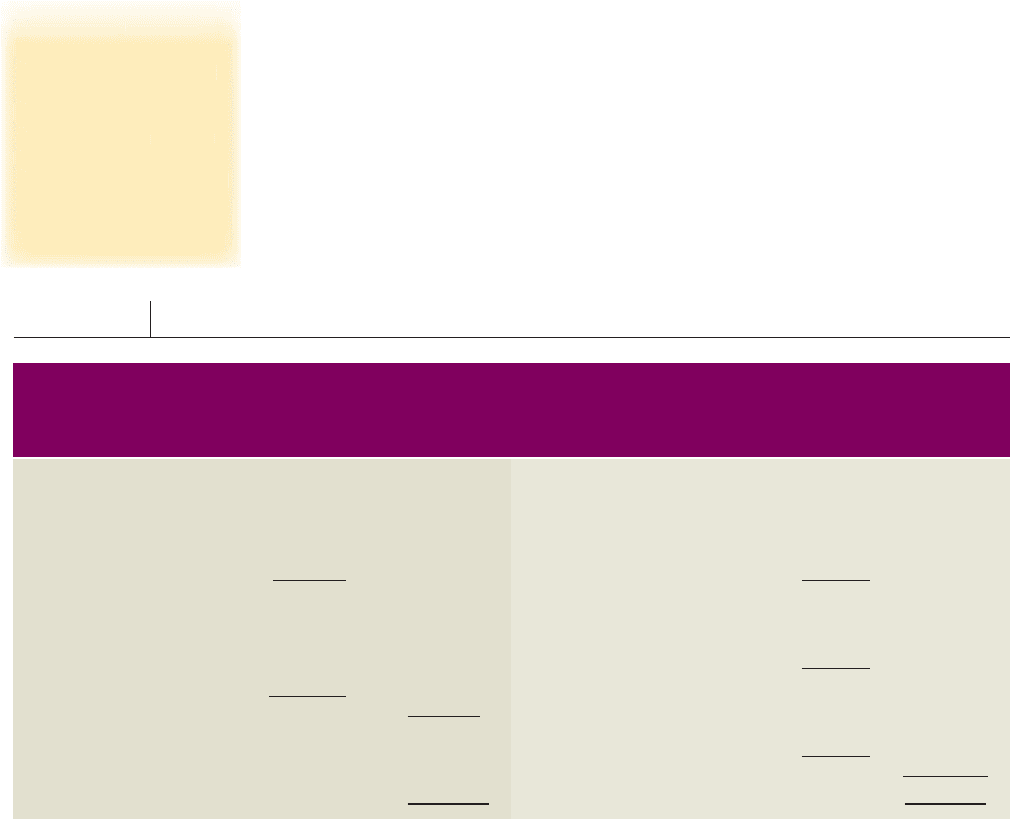
PART 6 CONTROLLING546
FINANCIAL CONTROL
In every organization, managers need to watch how well the organization is per-
forming nancially. Not only do nancial controls tell whether the organization is
on sound nancial footing, but they can be useful indicators of other kinds of perfor-
mance problems. For example, a sales decline may signal problems with products,
customer service, or sales force effectiveness.
Financial Statements
Financial statements provide the basic information used for nancial control of an
organization. Two major nancial statements—the balance sheet and the income
statement—are the starting points for nancial control.
The balance sheet shows the rm’s nancial position with respect to assets and liabil-
ities at a speci c point in time. An example of a balance sheet is presented in Exhibit 18.3.
The balance sheet provides three types of information: assets, liabilities, and owners’
equity. Assets are what the company owns, and they include current assets (those that
can be converted into cash in a short time period) and xed assets (such as buildings and
equipment that are long term in nature). Liabilities are the rm’s debts, including both cur-
rent debt (obligations that will be paid by the company in the near future) and long-term
debt (obligations payable over a long period). Owners’ equity is the difference between
assets and liabilities and is the company’s net worth in stock and retained earnings.
The income statement, sometimes called a pro t-and-loss statement or P&L for
short, summarizes the rm’s nancial performance for a given time interval, usu-
ally one year. A sample income statement is shown in Exhibit 18.4. Some organi-
zations calculate the income statement at three-month intervals during the year to
see whether they are on target for sales and pro ts. The income statement shows
revenues coming into the organization from all sources and subtracts all expenses,
including cost of goods sold, interest, taxes, and depreciation. The bottom line indi-
cates the net income—pro t or loss—for the given time period.
The owner of Aahs!, a specialty retailing chain in California, used the income state-
ment to detect that sales and pro ts were dropping signi cantly during the summer
months.
30
He immediately evaluated company activities and closed two money-losing
New Creations Landscaping
Consolidated Balance Sheet
December 31, 2009
Assets Liabilities and Owners’ Equity
Current assets: Current liabilities:
Cash $ 25,000 Accounts payable $200,000
Accounts receivable 75,000 Accrued expenses 20,000
Inventory 500,000 Income taxes payable 30,000
Total current assets $ 600,000 Total current liabilities $ 250,000
Fixed assets: Long-term liabilities:
Land 250,000 Mortgages payable 350,000
Buildings and fi xtures 1,000,000 Bonds outstanding 250,000
Less depreciation 200,000 Total long-term liabilities $ 600,000
Total fi xed assets 1,050,000 Owners’ equity:
Common stock 540,000
Retained earnings 260,000
Total owners’ equity 800,000
Total assets $1,650,000 Total liabilities and net worth $1,650,000
EXHIBIT 18.3 Balance Sheet
b
b
b
b
b
b
bal
ance s
h
eet
Afi
Afi
A
fi
na
na
i
nci
nci
l
al
al
s
s
s
s
s
st
t
atement t
h
at s
h
ows t
h
e
fi
rm’
s
s
s
s
fi
fi
fi
fi
fi
nancial
p
osition with res
p
ect
t
t
t
o
o
assets
a
n
d
li
ab
ili
t
i
es
at
a
s
s
s
s
sp
p
ecifi c point in time
.
i
i
i
i
i
ncome statement
A
fi
nan-
c
c
c
c
ci
i
a
l
statement t
h
at summarize
s
s
t
t
t
h
h
h
e fi rm’s fi nancial
p
erformanc
e
e
e
e
f
f
f
fo
o
o
r a
g
iven time interval; some
-
-
t
t
t
i
i
m
t
es called a profi t-and-loss
s
s
s
st
st
ta
ta
s
te
m
e
n
t
.
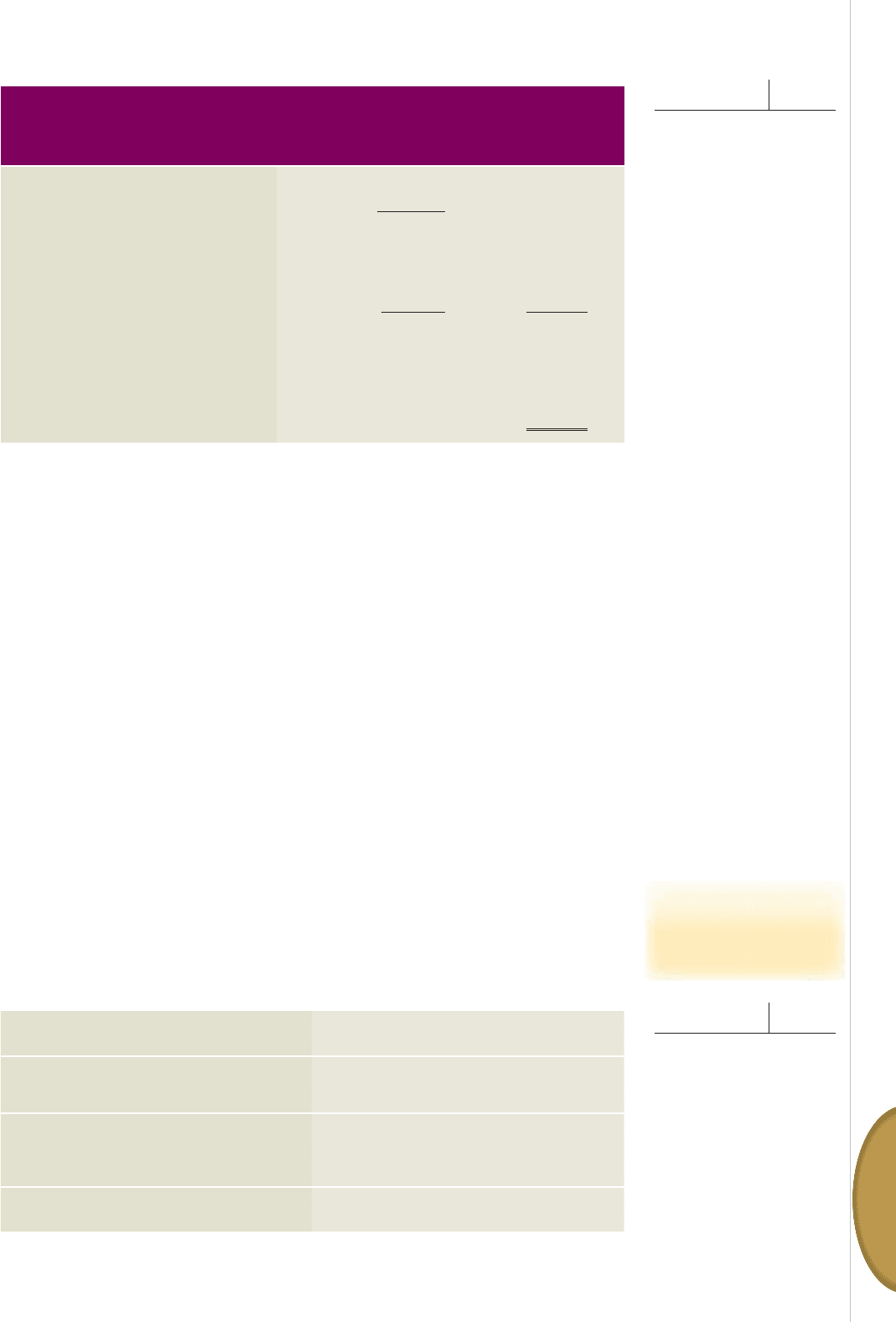
CHAPTER 18 MANAGING QUALITY AND PERFORMANCE 547
Controlling
6
stores. He also began a training program to teach employees how to increase sales and
cut costs to improve net income. This use of the income statement follows the control
model described in the previous section, beginning with setting targets, measuring actual
performance, and then taking corrective action to improve performance to meet targets.
Financial Analysis: Interpreting the Numbers
A manager needs to be able to evaluate nancial reports that compare the organiza-
tion’s performance with earlier data or industry norms. These comparisons enable
the manager to see whether the organization is improving and whether it is com-
petitive with others in the industry. The most common nancial analysis focuses on
ratios, statistics that express the relationships between performance indicators such
as pro ts and assets, sales, and inventory. Ratios are stated as a fraction or propor-
tion; Exhibit 18.5 summarizes some nancial ratios, which are measures of an organi-
zation’s liquidity, activity, pro tability, and leverage. These ratios are among the most
common, but many measures are used. Managers decide which ratios reveal the most
important relationships for their business.
Liquidity Ratios A liquidity ratio indicates an organization’s ability to meet its
current debt obligations. For example, the current ratio (current assets divided by cur-
rent liabilities) tells whether the company has suf cient assets to convert into cash
to pay off its debts, if needed. If a hypothetical company, Oceanographics, Inc., has
current assets of $600,000 and current liabilities of $250,000, the current ratio is 2.4,
meaning it has suf cient funds to pay off immediate debts 2.4 times. This level for the
current ratio is normally considered a satisfactory margin of safety.
New Creations Landscaping
Income Statement
For the Year Ended December 31, 2009
Gross sales $3,100,000
Less sales returns 200,000
Net sales $2,900,000
Less expenses and cost of goods sold:
Cost of goods sold 2,110,000
Depreciation 60,000
Sales expenses 200,000
Administrative expenses 90,000 2,460,000
Operating profi t 440,000
Other income 20,000
Gross income 460,000
Less interest expense 80,000
Income before taxes 380,000
Less taxes 165,000
Net income $ 215,000
EXHIBIT 18.4
Income Statement
EXHIBIT 18.5
Common Financial Ratios
Liquidity Ratios
Current ratio Current assets/Current liabilities
Activity Ratios
Inventory turnover
Conversion ratio
Total sales/Average inventory
Purchase orders/Customer inquiries
Profi tability Ratios
Profi t margin on sales
Gross margin
Return on assets (ROA)
Net income/Sales
Gross income/Sales
Net income/Total assets
Leverage Ratios
Debt ratio Total debt/Total assets
l
l
l
l
li
li
liq
uidit
y
ratio
Afi
A
fi
na
na
nci
nci
al
al
r
r
r
ra
at
r
r
r
ra
at
r
i
io
io
h
tha
tha
i
ti
t
i
di
ndi
ndi
cat
cat
es
es
h
the
the
or
or
gan
gan
g
i
iza
a
iza
a
-
-
-
t
t
t
i
i
i
on’s ability to meet its current
d
d
d
de
de
deb
eb
d
d
t obli
g
at
g
ions.

PART 6 CONTROLLING548
Activity Ratios An activity ratio measures internal performance with respect to key
activities de ned by management. For example, inventory turnover is calculated by
dividing total sales by average inventory. This ratio tells how many times the inven-
tory is used up to meet the total sales gure. If inventory sits too long, money is wasted.
Dell Inc. achieved a strategic advantage by minimizing its inventory costs. Dividing
Dell’s annual sales by its small inventory generates an inventory turnover rate of 35.7.
31
Another type of activity ratio, the conversion ratio, is purchase orders divided by cus-
tomer inquiries. This ratio is an indicator of a company’s effectiveness in converting
inquiries into sales. For example, if Cisco Systems moves from 26.5 to 28.2 percent con-
version ratio, more of its inquiries are turned into sales, indicating better sales activity.
Profi tability Ratios Managers analyze a company’s pro ts by studying pro t-
ability ratios, which state pro ts relative to a source of pro ts, such as sales or assets.
One important pro tability ratio is the pro t margin on sales, which is calculated as
net income divided by sales. Similarly, gross margin is the gross (before-tax) pro t
divided by total sales. Managers at Tesco.com, the online grocery service of Britain’s
top supermarket chain, pay close attention to the pro t margin. Tesco.com managers
implemented strict nancial controls from the beginning. The online division was
immediately pro table, earning about $6 on the average online sale, whereas U.S.-
based Webvan, which eventually failed, lost about $100 per sale because of its huge
start-up costs and high operating expenses.
32
Another pro tability measure is return on total assets (ROA), which is a percentage
representing what a company earned from its assets, computed as net income divided
by total assets. ROA is a valuable yardstick for comparing a company’s ability to gener-
ate earnings with other investment opportunities. In basic terms, the company should
be able to earn more by using its assets to operate the business than it could by putting
the same investment in the bank. Caterpillar Inc., which produces construction and min-
ing equipment, uses return on assets as its main measure of performance. It sets ROA
standards for each area of the business and uses variances from the standards to iden-
tify whether the company is fully using its assets and improving operational ef ciency.
Since it began using ROA standards, Caterpillar has enjoyed double-digit returns.
33
Leverage Ratios Leverage refers to funding activities with borrowed money. A company
can use leverage to make its assets produce more than they could on their own. However,
too much borrowing can put the organization at risk such that it will be unable to keep up
with repayment of its debt. Managers therefore track their debt ratio, or total debt divided
by total assets, to make sure it does not exceed a level they consider acceptable. Lenders
may consider a company with a debt ratio above 1.0 to be a poor credit risk.
THE CHANGING PHILOSOPHY OF CONTROL
Managers’ approach to control is changing in many of today’s organizations. In con-
nection with the shift to employee participation and empowerment, many companies
are adopting a decentralized rather than a hierarchical control process. Hierarchical con-
trol and decentralized control represent different philosophies of corporate culture,
which was discussed in Chapter 3. Most organizations display some aspects of both
hierarchical and decentralized control, but managers generally emphasize one or the
other, depending on the organizational culture and their own beliefs about control.
Hierarchical versus Decentralized Approaches
Hierarchical control involves monitoring and in uencing employee behavior
through extensive use of rules, policies, hierarchy of authority, written documen-
tation, reward systems, and other formal mechanisms.
34
In contrast, decentralized
a
a
a
a
a
act
i
v
i
ty rat
i
o
A
fi nancial rat
io
io
o
o
o
o
o
t
t
t
h
ha
h
ha
tm
t
m
eas
eas
ure
ure
st
s
t
he
he
org
org
ani
ani
za
-
za
t
t
i
o
t
i
o
t
n
’
s
ns
in
in
ter
ter
nal
nal
pe
pe
rfo
rfo
rma
rma
nce
nce
w
w
w
w
wit
w
w
w
wit
hr
h
r
esp
esp
ect
ect
to
to
ke
ke
ya
y
a
cti
cti
vit
vit
ies
ies
d
d
d
d
d
efi ned b
y
mana
g
ement.
p
p
p
p
p
rofi tability ratio
A
fi
nanci
a
al
l
l
l
r
r
r
r
ra
at
i
o
t
h
at
desc
ri
bes
t
h
e
fi rm’
s
p
p
p
p
p
rofi ts in terms of a source of
p
p
p
p
p
rofi ts (for example, sales or
t
t
t
o
o
tal assets).
h
h
h
h
h
i
e
r
a
r
c
hi
ca
l
co
n
t
r
o
l The us
e
e
e
o
o
o
o
of
f
rules, policies, hierarchy of
a
a
a
a
au
u
thorit
y
, reward s
y
stems, and
o
o
o
o
ot
t
h
e
r f
o
rm
a
l
de
vi
ces
to
infl
u-
e
e
e
e
en
n
ce emplo
y
ee behavior and
a
a
a
a
as
s
sess per
f
ormance.
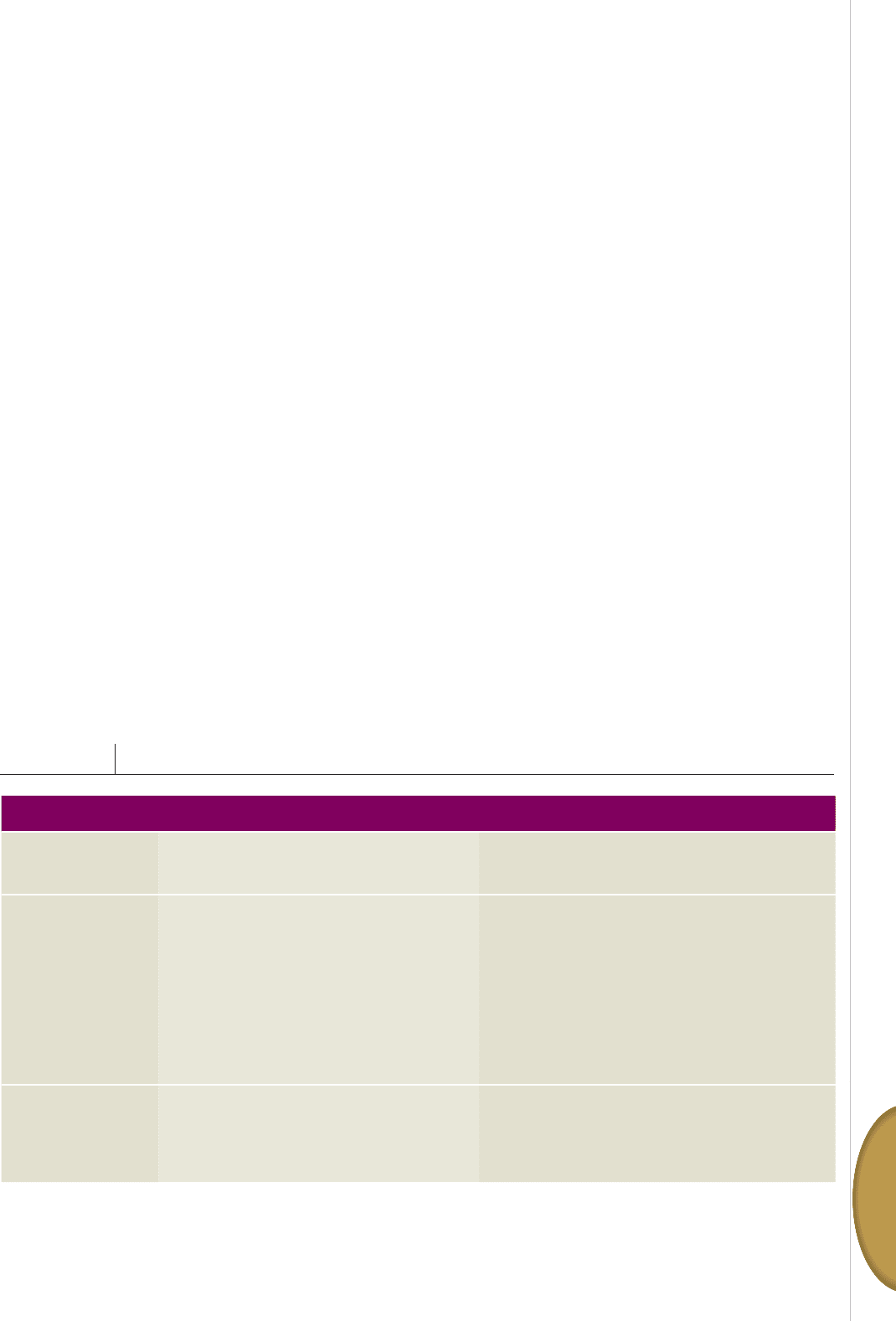
CHAPTER 18 MANAGING QUALITY AND PERFORMANCE 549
Controlling
6
control relies on cultural values, traditions, shared beliefs, and trust to foster compli-
ance with organizational goals. Managers operate on the assumption that employees
are trustworthy and willing to perform effectively without extensive rules and close
supervision.
Exhibit 18.6 contrasts the use of hierarchical and decentralized methods of con-
trol. Hierarchical methods de ne explicit rules, policies, and procedures for employee
behavior. Control relies on centralized authority, the formal hierarchy, and close
personal supervision. Responsibility for quality control rests with quality control
inspectors and supervisors rather than with employees. Job descriptions generally
are speci c and task related, and managers de ne minimal standards for acceptable
employee performance. In exchange for meeting the standards, individual employ-
ees are given extrinsic rewards such as wages, bene ts, and possibly promotions up
the hierarchy. Employees rarely participate in the control process, with any partici-
pation being formalized through mechanisms such as grievance procedures. With
hierarchical control, the organizational culture is somewhat rigid, and managers do
not consider culture a useful means of controlling employees and the organization.
Technology often is used to control the ow and pace of work or to monitor employ-
ees, such as by measuring the number of minutes employees spend on phone calls or
how many keystrokes they make at the computer.
Hierarchical control techniques can enhance organizational ef ciency and
effectiveness. Many employees appreciate a system that clari es what is expected
of them, and they may be motivated by challenging, but achievable goals.
35
How-
ever, although many managers effectively use hierarchical control, too much con-
trol can back re. Employees resent being watched too closely, and they may try
to sabotage the control system. One veteran truck driver expressed his unhappi-
ness with electronic monitoring to a Wall Street Journal reporter investigating the
use of devices that monitor truck locations. According to the driver, “It’s getting
worse and worse all the time. Pretty soon they’ll want to put a chip in the drivers’
ears and make them robots.” He added that he occasionally escapes the relentless
monitoring by parking under an overpass to take a needed nap out of the range of
the surveillance satellites.
36
Hierarchical Control Decentralized Control
Basic Assumptions People are incapable of self-discipline and can-
not be trusted. They need to be monitored and
controlled closely.
People work best when they are fully committed to the
organization.
Actions Uses detailed rules and procedures; formal
control systems.
Uses top-down authority, formal hierarchy,
position power, quality control inspectors.
Relies on task-related job descriptions.
Emphasizes extrinsic rewards (pay, benefi ts,
status).
Features rigid organizational culture; distrust of
cultural norms as means of control.
Features limited use of rules; relies on values, group
and self-control, selection, and socialization.
Relies on fl exible authority, fl at structure, expert power;
everyone monitors quality.
Relies on results-based job descriptions; emphasizes
goals to be achieved.
Emphasizes extrinsic and intrinsic rewards (meaningful
work, opportunities for growth).
Features adaptive culture; culture recognized as means
for uniting individual, team, and organizational goals
for overall control.
Consequences Employees follow instructions and do just what
they are told.
Employees feel a sense of indifference toward
work.
Employee absenteeism and turnover is high.
Employees take initiative and seek responsibility.
Employees are actively engaged and committed to their
work.
Employee turnover is low.
SOURCES: Based on Naresh Khatri, Alok Bavega, Suzanne A. Boren, and Abate Mammo, “Medical Errors and Quality of Care: From Control to Commitment,” California
Management Review 48, no. 3 (Spring, 2006): 118; Richard E. Walton, “From Control to Commitment in the Workplace,” Harvard Business Review (March–April 1985): 76–84;
and Don Hellriegel, Susan E. Jackson, and John W. Slocum, Jr., Management, 8th ed. (Cincinnati, Ohio: South-Western, 1999), p. 663.
EXHIBIT 18.6 Hierarchical and Decentralized Methods of Control
